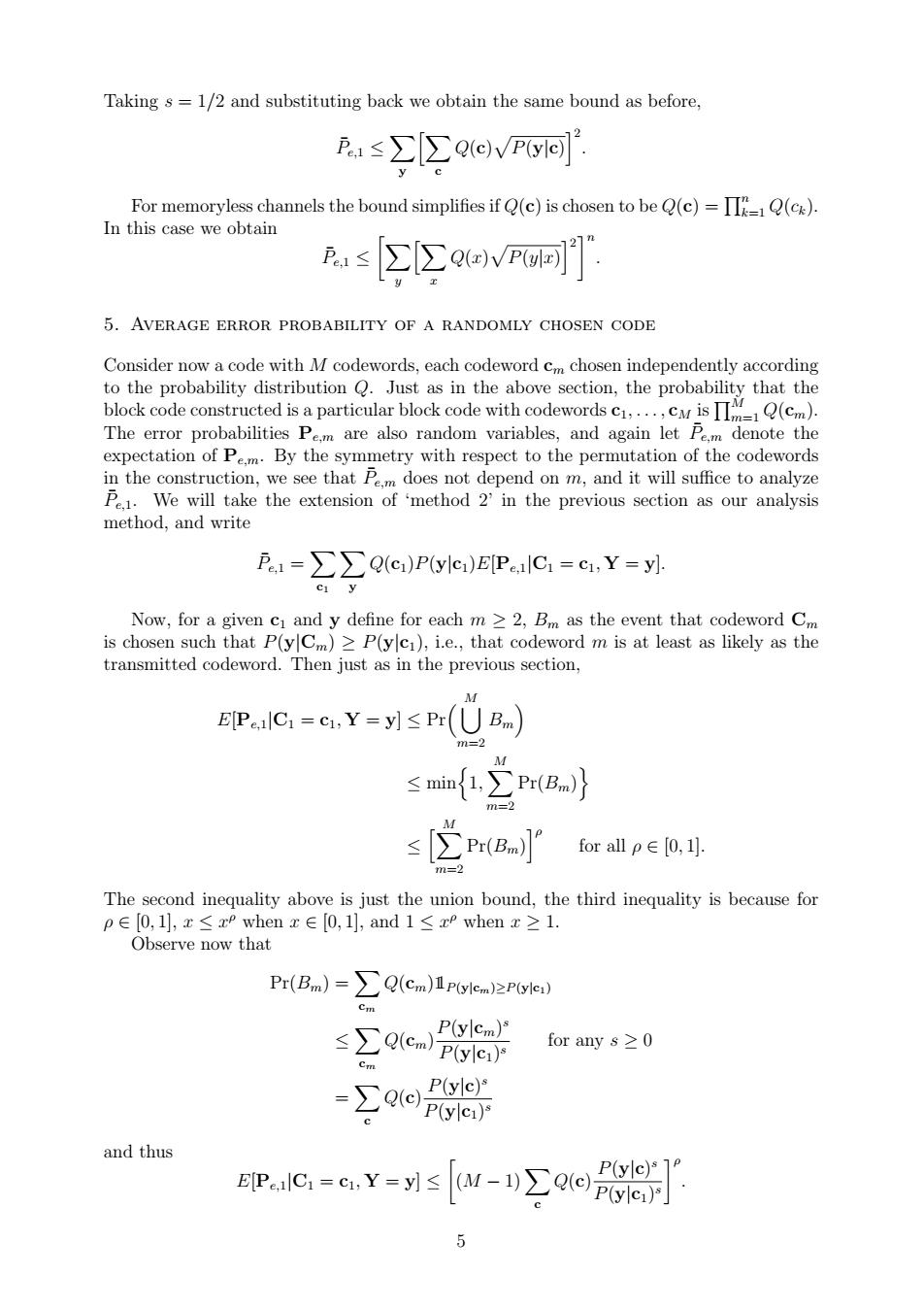正在加载图片...

Taking s=1/2 and substituting back we obtain the same bound as before, p,≤∑∑Q(c)vPyo可 channels the bound simplifies if (c)is chosen to beQ(c)=(c). ≤∑[∑Q()vF( 5.AVERAGE ERROR PROBABILITY OF A RANDOMLY CHOSEN CODE Consider now a code with M codewords,each codeword cm chosen independently according to the probability distribution Q.Just as in the above section,the probability that the block code constructed is a particular block code with codewords c1,.,ca is =Q(cm). The error probabilities Pe.m are also random variables,and again let Pem denote the expectation of Pe.m.By the symmetry with respect to the permutation of the codewords in the construction,we see that P.m does not depend on m,and it will suffice to analyze P.1.We will take the extension of 'method 2'in the previous section as our analysis method,and write P1=∑∑Q(c)Pylc)E[PealC=c,Y=y c1 y Now,for a given c and y define for each m >2,Bm as the event that codeword C is chosen such that P(yC)P(ylc),i.e.,that codeword m is at least as likely as the transmitted codeword.Then just as in the previous section, EPlC1=c,Y=y≤Pr(UBn) m2 ≤mim1,∑Pr(Bn)} ≤[∑Pr(Bjr for all p[0,1]. m=2 The second inequality above is just the union bound,the third inequality is because for p∈0,1,x≤z when r∈0,1],and1≤z when r≥l. Observe now that Pr(Bm)=>Q(Cm)1p(ylem)2P(yle) ≤Σee for any s0 Cm -2oo0器 and thus EP.lC=c,Y=≤W-)∑Qoe· P(ylc)sle Taking s = 1/2 and substituting back we obtain the same bound as before, P¯ e,1 ≤ X y hX c Q(c) p P(y|c) i2 . For memoryless channels the bound simplifies if Q(c) is chosen to be Q(c) = Qn k=1 Q(ck). In this case we obtain P¯ e,1 ≤ X y hX x Q(x) p P(y|x) i2 n . 5. Average error probability of a randomly chosen code Consider now a code with M codewords, each codeword cm chosen independently according to the probability distribution Q. Just as in the above section, the probability that the block code constructed is a particular block code with codewords c1, . . . , cM is QM m=1 Q(cm). The error probabilities Pe,m are also random variables, and again let P¯ e,m denote the expectation of Pe,m. By the symmetry with respect to the permutation of the codewords in the construction, we see that P¯ e,m does not depend on m, and it will suffice to analyze P¯ e,1. We will take the extension of ‘method 2’ in the previous section as our analysis method, and write P¯ e,1 = X c1 X y Q(c1)P(y|c1)E[Pe,1|C1 = c1, Y = y]. Now, for a given c1 and y define for each m ≥ 2, Bm as the event that codeword Cm is chosen such that P(y|Cm) ≥ P(y|c1), i.e., that codeword m is at least as likely as the transmitted codeword. Then just as in the previous section, E[Pe,1|C1 = c1, Y = y] ≤ Pr [ M m=2 Bm ≤ minn 1, X M m=2 Pr(Bm) o ≤ hX M m=2 Pr(Bm) iρ for all ρ ∈ [0, 1]. The second inequality above is just the union bound, the third inequality is because for ρ ∈ [0, 1], x ≤ x ρ when x ∈ [0, 1], and 1 ≤ x ρ when x ≥ 1. Observe now that Pr(Bm) = X cm Q(cm)11P(y|cm)≥P(y|c1) ≤ X cm Q(cm) P(y|cm) s P(y|c1) s for any s ≥ 0 = X c Q(c) P(y|c) s P(y|c1) s and thus E[Pe,1|C1 = c1, Y = y] ≤ (M − 1)X c Q(c) P(y|c) s P(y|c1) s ρ . 5